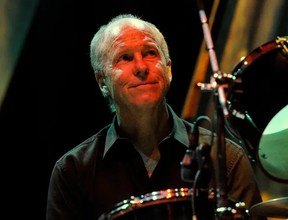Gordon Lightfoot and his band ensured the 29 souls lost when the freighter sank in Lake Superior are still remembered 50 years later.
Article content
It was one of those magical circumstances that legends are made of.
Advertisement 2
Article content
In this case, the legend lives on not just on the tragic sinking of the SS Edmund Fitzgerald ship but in the song written and performed by Gordon Lightfoot that memorialized it forever.
Article content
Article content
This November 10th marks 50 years since the massive 729-foot-long laker sunk in a major storm on Lake Superior and next year will hit the half century mark of some very interesting developments that led to Lightfoot writing The Wreck of the Edmund Fitzgerald – the song that helped keep the memories of the 29 lost Great Lakes sailors alive.
But if not for a strange series of events, the classic song may never have come into existence.
Lightfoot’s iconic drummer of almost a half century, Barry Keane, remembers first hearing about the wreck when being brought into to do percussion for the recording on the 1976 Summertime Dream album.
Advertisement 3
Article content

“We were in rehearsal going into the studio when after going through a lot of the songs from the album, Gordon started strumming the chords and singing some of the lyrics to what would eventually become one of the world’s most famous songs.
“We all said, ‘Hey what’s that?’” recalled Keane. “Gordon said, ‘Oh, it’s a song I am working on from a story I read in a magazine about a ship that sunk in Lake Superior.’”
Keane recalled Gordon saying not to ‘worry about it, it’s not for this album. It’s not ready yet.’”

IT WAS SERENDIPITY THAT LED TO RECORDING LEGENDARY TRACK
A few weeks later, after they had finished 13 tracks, Lightfoot started strumming the song again.
“We all said, again, ‘Why don’t we do that one,’” recalls Keane. “Gordon was adamant it just wasn’t ready.”
Article content
Advertisement 4
Article content
Who knows if it ever would have been had the next thing not happened.
“Recording engineer Ken Friesen from the booth at Eastern Sound piped in and said, “Gord, you have got all the guys here, why don’t you get some of it down on tape while we have the studio.”
Advertisement 5
Article content
At that moment Peewee Charles on Steel Guitar and guitarist Terry Clements nodded and together harmonized their respective instruments to create that iconic and haunting guitar riff that when heard is immediately recognizable today.
Keane recalls Gordon telling him he’d give him a nod when to come in on drums, and Friesen started recording.
WHEN THEY RECORDED ‘THE WRECK’ THE BAND HAD NEVER HEARD IT BEFORE
“I was sitting there listening to this song that I had never heard before and it was going on for quite a while, and I was wondering did Gord forgot to give me the nod. But then he did,” Keane explains.
You can hear Keane come in with his now legendary drum fill to explode this tale and fable to historic levels. When he hits those toms and puts in his first roll, it’s like a haunting punch to the gut reminding listeners that this is a song about men losing their lives.
Advertisement 6
Article content
Keane’s drumming is as vital to this song as the incredible guitar work and Lightfoot’s chilling narration in that it shakes up the listener to remember this was a battle for life.
This was not lost on the musicians who wanted to bring honour to those men in their performance. When they finished that first take, Keane said all of the guys were moved by Gordon’s lyrics, his vocal performance, and his passion.
“We knew it was good track but there’s no way anybody thought it was going to be a hit record. It was, after all, a six-and-a-half-minute song with no chorus about men who died. But we were all feeling emotional after it.”
Advertisement 7
Article content
DIVINE INTERVENTION
They decided to run through it a couple more times.
“But none of the next takes were as good as that first time we played it, writing our parts on the spot and having never heard it before,” he said. “What you hear now, is that first take.”
It was serendipitous. Like divine intervention.
“You have to think so,” said Keane, adding how else can you explain musicians recording a song they hadn’t heard before with a singer who was still writing the lyrics.
“It’s an amazing situation,” said Keane. “When you listen to it, you can hear the tension we were all playing with because we really didn’t know what our parts were.”
Advertisement 8
Article content
They just went on gut feel – never realizing a half century later the song would be a classic.
But the serendipity was not over.
Warner Brothers Records Chairman and CEO Mo Ostin was the next person to play a hand in what ended up being a major jackpot.
Lightfoot did include The Wreck of the Edmund Fitzgerald on the album but never thought of it as a radio airplay single.
“We were out in L.A. meeting about what the second single would be and it didn’t come up,” said Keane.
At least, not until Ostin brought it up.
The original idea was to edit it down to a four-minute single for radio but with FM stations having already discovered it, the longer, original version ended up being played on every station.
HISTORICAL SONG CAME BY ACCIDENT
The rest, as they say, is history.
Advertisement 9
Article content
“I knew it was a great track,” said Keane.
But for the next almost 50 years he learned it was much more than a music track.
“We have met the wives, the son’s and the daughters” of the men who died over many decades and it’s always emotional,” said Keane. “We also met many people along the way who talked about how Gordon’s music helped them get through tough times or surviving during war.”
Advertisement 10
Article content
On this 50th anniversary of the ship sinking, Keane thinks of these men the 29 bells rang for and their families, but he also thinks of the man they rang the 30th bell for at the Mariner’s Church of Detroit for when he died on May 1, 2023.
“Gordon was a very humble man,” he said. “He cared about people.”
He helped keep the memory of these mariners alive and in its own way the anniversary of their ship sinking to the bottom of Lake Superior serves as a reminder of the great legacy of Gordon Lightfoot as well.
Read More
GALES OF NOVEMBER
But Keane said the song helped do more than that.
Advertisement 11
Article content
“The author the Gales of November book John Bacon tells us that since the wreck of the Edmund Fitzgerald, awareness and changed safety standards have resulted in no further commercial mariner deaths on the Great Lakes since.”
Now that’s a legacy.
And those mariners on board who were never recovered are still remembered as we mark 50th anniversary of the disaster on Tuesday.
Thanks to Gordon Lightfoot and supporting musicians who met the moment, their legend lives on.
The Wreck of the Edmund Fitzgerald by Gordon Lightfoot
(lyrics)
The legend lives on from the Chippewa on downOf the big lake, they called Gitche GumeeThe lake, it is said, never gives up her deadWhen the skies of November turn gloomyWith a load of iron ore, twenty-six thousand tons moreThan the Edmund Fitzgerald weighed emptyThat good ship and true was a bone to be chewedWhen the gales of November came early
The ship was the pride of the American sideComing back from some mill in WisconsinAs the big freighters go, it was bigger than mostWith a crew and good captain well seasonedConcluding some terms with a couple of steel firmsWhen they left fully loaded for ClevelandAnd later that night when the ship’s bell rangCould it be the north wind they’d been feeling?
The wind in the wires made a tattle-tale soundAnd a wave broke over the railingAnd every man knew, as the captain did too‘Twas the witch of November come stealingThe dawn came late, and the breakfast had to waitWhen the gales of November came slashin’When afternoon came, it was freezin’ rainIn the face of a hurricane west wind
When suppertime came, the old cook came on deck sayin’“Fellas, it’s too rough to feed ya”At seven p.m., a main hatchway caved in, he said“Fellas, it’s been good to know ya”The captain wired in he had water comin’ inAnd the good ship and crew was in perilAnd later that night when his lights went outta sightCame the wreck of the Edmund Fitzgerald
Does anyone know where the love of God goesWhen the waves turn the minutes to hours?The searchers all say they’d have made Whitefish BayIf they’d put 15 more miles behind herThey might have split up or they might have capsizedThey may have broke deep and took waterAnd all that remains is the faces and the namesOf the wives and the sons and the daughters
Lake Huron rolls, Superior singsIn the rooms of her ice-water mansionOld Michigan steams like a young man’s dreamsThe islands and bays are for sportsmenAnd farther below Lake OntarioTakes in what Lake Erie can send herAnd the iron boats go as the mariners all knowWith the gales of November remembered
In a musty old hall in Detroit, they prayedIn the Maritime Sailors’ CathedralThe church bell chimed ’til it rang twenty-nine timesFor each man on the Edmund FitzgeraldThe legend lives on from the Chippewa on downOf the big lake, they call Gitche GumeeSuperior, they said, never gives up her deadWhen the gales of November come early
Advertisement 12
Article content
The 29 crew who died on board the Edmund Fitzgerald
- Captain: Ernest M. McSorley
- Mates: John H. McCarthy (First Mate), James A. Pratt (Second Mate), Michael E. Armagost (Third Mate)
- Engineers: George J. Holl (Chief Engineer), Edward F. Bindon (First Assistant Engineer), Thomas E. Edwards (Second Assistant Engineer), Oliver J. Champeau (Third Assistant Engineer)
- Oilers: Ralph Walton, Blaine Wilhelm, and Thomas D. Bentsen
- Porters: Frederick J. Beetcher and Nolan S. Church
- Watchmen: Ransom E. Cundy, Karl A. Peckol, and William Spengler
- Deckhands: Paul Riippa, Mark Thomas, and Bruce Hudson
- Wheelsmen: John Poviach, John Simmons, and Eugene W. O’Brien
- Steward: Allen G. Kalmon (also listed as Second Cook)
- Others: Thomas D. Borgeson (Maintenance Man), Joseph W. Mazes (Special Maintenance Man), David Weiss (Cadet), and Gordon F. MacLellan (Wiper)
Article content











